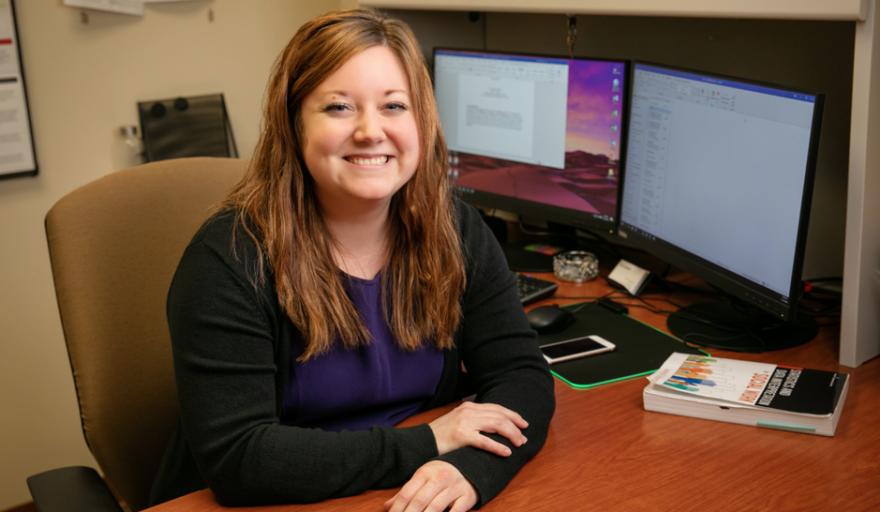Social Work Team Leads Efforts in Creating Statewide Violence Prevention Plan
November 04, 2021

The School of Social Work took the lead in compiling and assessing violence data county by county and coordinating a multiagency collaboration to address and prevent future violence, which occurs in disproportionate measures among minority and marginalized groups.
Across the state of Illinois, violence occurs at higher rates among certain racial and marginalized groups, says Rachel Garthe, assistant professor and undergraduate research program coordinator for the School of Social Work.
That’s one of the findings in a study led by Garthe, who is principal investigator on two grants funded through the Illinois Criminal Justice Information Authority (ICJIA). Professor Doug Smith is co-investigator on both grants.
Disproportionate Violence
“We’re opening people’s eyes to the different types of violence that happens and how it happens disproportionately to certain groups of people across the state—and how we can do better to meet the needs of those people who have experienced violence or trauma,” says Garthe.
For example, in the first study Garthe, Smith, and their research team found that:
- 81 percent of black adults reported at least one adverse childhood experience, compared to 71 percent of Hispanics and 57 percent of whites.
- Black youths and adults experience higher rates of juvenile detention and adult arrests and convictions for violent offenses.
- The firearm death rate is higher among black adults than among whites and Hispanics
- Youth who identify as lesbian, gay, bisexual, transgender, queer or questioning, and other sexual and gender identities (LGBTQ+) experience higher rates of youth violence than non-LGBTQ+ youths.
“We also found that child maltreatment and rates of youth bullying were particularly high in rural counties,” Garthe says. “We often think that violence is concentrated in urban areas, but we saw quite elevated rates in many rural counties in Illinois.”
Prevention Plan
The purpose of the first ICJIA grant was to come up with a four-year violence prevention plan, through 2024, which set funding goals and priorities for ICJIA. To that end, the researchers conducted a comprehensive needs assessment, which included analyzing reports and data from recent years, collecting additional data to address gaps, and generating a plan that is responsive to those needs in collaboration with multiple agencies and entities across the state.
The plan, Garthe says, focuses on strategies to stop the violence and promote safety; support children, youth, and families; advance equity; support health; and promote collaboration across state, municipal, and community-based agencies.
“The rates of violence and disparities highlighted in this report can be difficult to read,” Garthe says. “Violence is widespread and disproportionally impacts historically marginalized groups. The goals of this plan aim to address these inequities by increasing access to grant and economic opportunities, promote restorative justice, and prioritize trauma-informed practices across the state and within communities most impacted by violence.
“However, this is just a start. Focused and deliberate efforts need to ensue in order to begin the process of healing and finding justice within communities that have faced persistent inequities and other systemic barriers.”
“We also created county-level reports,” she says. “For all 102 counties we have every type of violence statistic possible. We’re making that data available to county officials.
“We want to be able to tell a story with that data. We want to give something meaningful back to those communities.”
The data, she says, will help counties and community-based organizations when they apply for funding or other resources in areas affected by violence, because the counties will have the necessary data and information at their fingertips.
Second Grant
The second ICJIA grant is related to the first grant. “We’ll continue the work around the implementation and dissemination of this statewide violence prevention plan,” Garthe says. “And we’ll be leading surveys, interviews, and focus groups to make sure the plan is regularly updated with perspectives and voices of the people most impacted by violence in their communities.”
In addition, she says, the team will continue to update violence data as it becomes available. “It’s important that violence statistics are compiled in a common hub for data accessibility and usability by community and state groups,” she says.
“The main point of all this is how can we work better as a team, as a collaborative entity, and as a state to strengthen school- and family-based programs, invest in communities, and strengthen early childhood programs so that we can prevent future violence from happening,” Garthe says. “We’re spreading awareness across the state and getting those conversations started.”
To learn more about this work, visit the Violence Prevention Research Lab website at https://violencepreventionresearchlab.com and the ICJIA website for the statewide violence prevention plan at https://vpp.icjia.cloud.